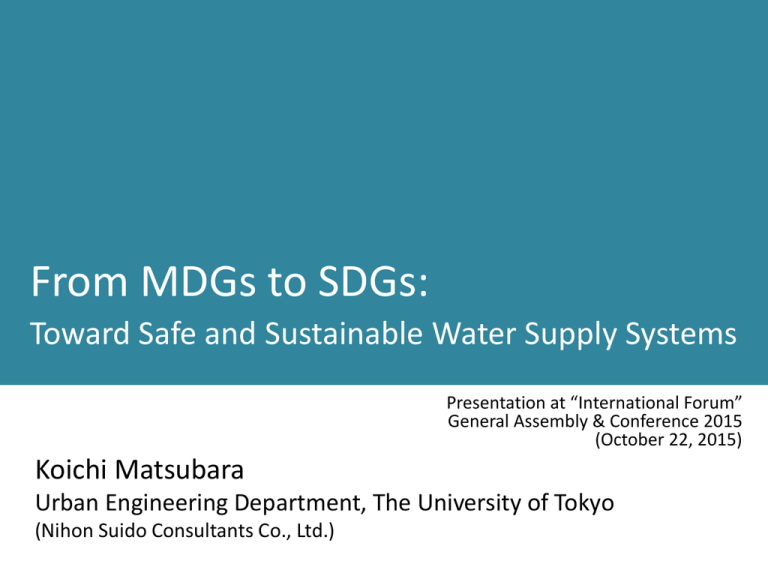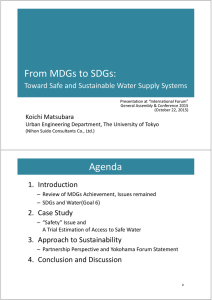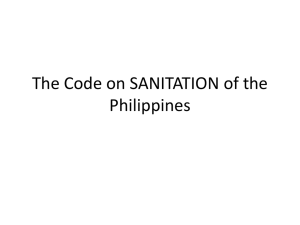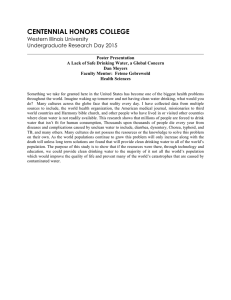Safe Drinking Water
advertisement

From MDGs to SDGs: Toward Safe and Sustainable Water Supply Systems Presentation at “International Forum” General Assembly & Conference 2015 (October 22, 2015) Koichi Matsubara Urban Engineering Department, The University of Tokyo (Nihon Suido Consultants Co., Ltd.) Agenda 1. Introduction – Review of MDGs Achievement, Issues remained – SDGs and Water(Goal 6) 2. Case Study – “Safety” Issue and A Trial Estimation of Access to Safe Water 3. Approach to Sustainability – Partnership Perspective and Yokohama Forum Statement 4. Conclusion and Discussion 2 Introduction Review of Achievement by MDGs related to Water Supply 3 Introduction (1/7) "2.6 billion people have gained access to an improved drinking water source since 1990" "91 per cent of the global population now uses an improved Source (Notes and Photo): Progress on Sanitation and Drinking Water drinking water source" WHO/UNICEF (2015) 4 Achievement and Issues Remained 1) Introduction (2/7) • MDG Target 7c has been met Halve, by 2015, the proportion of the population without sustainable access to safe drinking water and basic sanitation • Issues remained – “663 million people still lack improved drinking water sources” – “Safe” sources is Not always safe Safe = Improved Drinking Water Sources (Incl. Private Wells, Community Taps) – Inequality (income level, Rural&Urban etc.) – Non-household setting (Schools, Healthcare Facilities) *Source: Progress on Sanitation and Drinking Water WHO/UNICEF (2015) 5 Introduction (3/7) What is Sustainable Development Goals (SDGs)? - 193 countries adopted declaration as the goals after MDGs - specifying “supremely ambitious and transformational vision” - 17 Goals with 169 associated targets which are integrated and indivisible. Source: UN Sustainable Development Goals Website http://www.un.org/sustainabledevelopment/sustainable-development-goals/ 6 Introduction (4/7) Interlinkage of Goals and Water • Importance of Interlinkage with other Goals (Aside from Goal 6) “Saving women and girls time by reducing hours spent fetching water, improving productivity” *1 ⇒ Indicator: Percentage of households (disaggregated by sex of head of household) using safely managed drinking-water services Living Environment for Poor dwellers in Slums Equality for small subgroups (Poor, Disabilities, Ethnisity) Source:*1 WaterAid (2013) Everyone Everywhere *2 All Simbols are drawn from UN SDGs Websites http://www.un.org/sustainabledevelopment/sustainable-development-goals 7 Goal for “Water and Sanitation” • • • • • • • • • Introduction (5/7) Goal 6. Ensure availability and sustainable management of water and sanitation for all 6.1 by 2030, achieve universal and equitable access to safe and affordable drinking water for all 6.2 by 2030, achieve access to adequate and equitable sanitation and hygiene for all, and end open defecation, paying special attention to the needs of women and girls and those in vulnerable situations 6.3 by 2030, improve water quality by reducing pollution, eliminating dumping and minimizing release of hazardous chemicals and materials, halving the proportion of untreated wastewater, and increasing recycling and safe reuse by x% globally 6.4 by 2030, substantially increase water-use efficiency across all sectors and ensure sustainable withdrawals and supply of freshwater to address water scarcity, and substantially reduce the number of people suffering from water scarcity 6.5 by 2030 implement integrated water resources management at all levels, including through transboundary cooperation as appropriate 6.6 by 2020 protect and restore water-related ecosystems, including mountains, forests, wetlands, rivers, aquifers and lakes 6.a by 2030, expand international cooperation and capacity-building support to developing countries in water and sanitation related activities and programmes, including water harvesting, desalination, water efficiency, wastewater treatment, recycling and reuse technologies 6.b support and strengthen the participation of local 8 communities for improving water and sanitation management Source: UN Sustainable Development Goals Website Introduction (6/7) Goal 6 and Key Concept in Terminology 6.1 by 2030, achieve universal and equitable access to safe and affordable drinking water for all universal including households, schools, health facilities, workplaces equitable progressive reduction and elimination of inequalities between population sub-groups access close to home safe free from pathogens and elevated levels of toxic chemicals at all times affordable Payment for services does not present a barrier to access drinking water drinking, cooking, food preparation and personal hygiene for all men, women, girls and boys of all ages including people living with disabilities Source: Methodological note: Proposed indicator framework for monitoring SDG targets on drinking‐water, sanitation, hygiene and wastewater WHO/UNICEF (2015) 9 Introduction (7/7) Keywords in Goal 6 in Detail • Universal and Equitable – Gap between Urban and Rural, Rich and Poor – Non-household Settings (Schools and Hospitals) • Safe – Microbes (E. coli) and Important Chemicals (As, F) – Basic and Intermediate Services • Emerging Issues – – – – Water-use efficiency Water Resources Management Participation of local communities Partnerships …will be measured and monitored by individual indicators 10 Case Study “Safety” Issue and A Trial Estimation of Access to Safe Water 11 Water “Safety” Issues Case Study (1/7) • Improved water sources are not always safe – In a snapshot survey (RADWQ) for five countries, 7-16% of water supply did not complied with their water quality standards.1) – In an estimation, 1.2 billions are at sanitary risk2) • Sources of problems and limitations – Private Well: Source Pollution, Maintenance – Water Supply Systems: Intermittent supply, Demand Surge (Pressure drops), Source Pollution, O&M neglect – (Indirectly) Lack of Good Management, Finance, Human Resources 12 Source: 1) Bain et al., 2012, doi:10.2471/BLT.11.094284, 2) Onda et al., 2012, doi: 10.3390/ijerph9030880 Case Study (2/7) Trial Estimation of “Access to Safe Drinking Water” • Methodology: – “Access to Safe Drinking Water” Improved Water Water Quality complied with National Standards and WHO Water Quality Guideline values (As, E.coli) – Research Question: Does Household Water Treatment (HWT) contributed to provide safe water? Sand filter (SF) Reverse osmosis (RO) Ceramic Filter (CF) 13 Source: Matsubara et al., (2015) Submitting to Environmental Engineering Research, JSCE (in Japanese) Case Study (3/7) Case Study: Hanoi City • Hanoi City – Pop. 6.5 Million • • • Growing City Area and Populations Arsenic Problem Water Quality Survey – Hanoi, Vietnam – Sampling Period: from Nov. 2011 – Mar. 2013 • Questionnaire Survey – N=239 at Mar. 2012 World Bank Group (2015) East Asia's Changing Urban Landscape Measuring a Decade of Spatial 14Growth ISBN: 978-1-4648-0364-2 Case Study (4/7) Methodology: Estimation from Survey Results Questionnaire Survey Water Quality Survey n=239 71HHs, n=215 At Water Sources and HWTs (As; n=69, E.coli; n=43) Sort by HHs As and E. coli (42 HHs、49 Sources) Sort by residential area (r) Access at resource S (i,r) Improvement by HWT Safe ratio at Sources HWT prevalence X (j,r) (Y (j,r) ) (T (i,r) ) (AX, CF, FWF, RO, SF) (Piped, Private Well, Bottled, Rain) Access to Safe Drinking Water Sources Ps (r), Ph (r) Source: Matsubara et al., (2015) Submitting to Environmental Engineering Research, JSCE (in Japanese) 15 Case Study (5/7) Results: Estimation of Prevalence of HWT • Prevalence of HWT(by Questionnaire n=239) – 5 regions in Urban, Suburban, and Rural Areas 100% 90% 80% 16% Piped (16%) Piped (30%) 36% (64%) 70% Rain (35%) (55%) RO SF (9%) 40% 12% 30% 16% (25%) Bottled (2%) 19% 20% 25% 20% Well Bottled (4%) (4%) Bottled 10% (4%) 22% 12% 2% 8% 11% 11% 4% 9% ND (n=25) TA (n=64) NT (n=44) NH (n=57) Urban AX Piped 31% 50% 0% Rain Bottled 60% 10% Piped Direct Drink 63% 63% 66% 39% Suburban 4% TY (n=49) FWF CF NA NA: HWT Types not Identified Rural Types of Water Sources and Household Water Treatments Source: Matsubara et al., (2015) Submitting to Environmental Engineering Research, JSCE (in Japanese) 16 Case Study (6/7) Results: Estimation of Safe Water Access by regions • Safe Access is only 15% to 52% – Lower access in Suburban: Small Scale Water Supply which do not complied for As (>10 µg/L) and E. coli – (Limitations) Restricted to only surveyed area 100% Improvement by Household Water Treatment (Ph) Safe Access at Source (Ps) Safe Water Sccess (%) 90% 80% 70% 60% 13% 8% 50% 40% 30% 60% 20% 10% 20% 52% 15% 0% Urban (ND, TA n=89) Suburb (NH, NT n=101) Rural (TY, n=49) 17 Source: Matsubara et al., (2015) Submitting to Environmental Engineering Research, JSCE (in Japanese) Implication and Recommendation Case Study (7/7) • In a trial estimation in Hanoi, Household Water Treatments (HWTs) are prevalent and gains access to “Safe” drinking water sources (by 8-20%) • Results imply the need for incorporating HWTs into safe water provision strategy - Pond, Well + Water Wagon - Well + Point of Use Treatment - Piped Water + Bottled Water - Public Standpipe + Water Kiosk 18 Approach to Sustainability Yokohama Forum Statement and Perspective of Partnerships 19 Partnerships An Approach (1/3) • From finance to diversified form of partnership • New Types of Partnerships – Sharing Knowledge and Experiences by WOPs – Making synthetic agenda and solutions Executive Forum for Enhancing Sustainability on Urban Water Service in Asian Region on sustainable management of water utilities (in Yokohama, July 2014) 20 Key Findings and Outcomes on An Approach (2/3) “Executive Forum for Enhancing Sustainability” Raising Revenue Maintenance and Procurement - Vicious to Sustainable Cycle - Customer Satisfaction for Willingness to pay and higher water sales - Efficiency Improvement as NRW reduction for less expenditures - Preventive Maintenance - Standardization for better procurement - Strict monitoring and utilization of SOPs for implementation of Water Safety Plan Disaster Preparedness - Safe water for all principles must/can be achieved even when it is in emergencies. - Importance of leadership - Funding for restoration is needed Human Resources Development - Sustainable HRD programs for sustainable utility Internal training comes first but external center is also essential - HRD for Morals and Attitude Partnerships - With various actors, to learn from best examples - Mutual trust should be basis of partnerships - Asia Forum for Benchmarking and Monitoring Source: THE THIRD EXECUTIVE FORUM FOR ENHANCING SUSTAINABILITY ON URBAN WATER SERVICE IN ASIAN REGION - SUSTAINABLE MANAGEMENT OF WATER UTILITIES , JICA (2014) 21 Key Findings and Outcomes on An Approach (3/3) “Executive Forum for Enhancing Sustainability” Held by JICA and City of Yokohama, 2014 28 Utilitys/Government Bodies stated as Yokohama Forum Statement; 1. Customer Satisfaction has a key role at raising revenue 2. Efficiency can only be achieved under appropriate preventive maintenance practices 3. Disaster becomes increasingly serious to every single utility 4. Benchmarking is needed to facilitate partnerships Partnerships as a “WATER FAMILY” Source: THE THIRD EXECUTIVE FORUM FOR ENHANCING SUSTAINABILITY ON URBAN WATER SERVICE IN ASIAN REGION - SUSTAINABLE MANAGEMENT OF WATER UTILITIES JICA (2014) 22 Conclusion and Discussion Last Slide • Sustainability in a context of SDGs for water supply sector – should be universal, equitable, safe, affordable and for all – is not single goal but wider issues which should care for the interlinkage with other sectors • Challenge of safety is not only of water utilities but also of costumers and cities • Partnerships are essential for sustainability to tackle with the common and emerging issues on a solidarity as a “WATER FAMILY” 23 Acknowledgment • “Yokohama Forum” was held by JICA and Yokohama City. The synthesis was maid as a result of many utilities and organizations commitments including Japan Waterworks Association. • Data and Photos in Hanoi were taken by Dr. Do Thuan An • Original Research by Matsubara et al., (2015) was fully advised by Prof. Takizawa (University of Tokyo) and Dr. Kuroda (NIES) • Ms. Takahashi (WaterAid Japan) provided resources of SDGs



